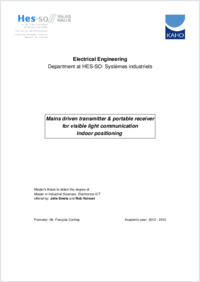Mains driven transmitter & portable receiver for visible light communication Indoor positioning
SONAR|HES-SO
- Smets, Jelle
- Holvoet, Rob
- Corthay, François (Degree supervisor)
-
2013
168
Mémoire de master: Haute Ecole d'Ingénierie, 2013
communication par la lumière visible
détermination du placement à l’intérieure
convertisseur flyback
récepteur optique
filtre de corrélation
Visible Light Communication (VLC)
indoor positioning
flyback converter
optical receiver
correlation filter
English
French
The possibilities of Visible Light Communication (VLC) for indoor positioning are being studied in this work. The placement of several LEDs on the ceiling can have a dual purpose: first, the lighting in the room and second the transmission of binary sequences. The binary sequences are send at a high frequency and are thus invisible for the human eye. A light receiving device can detect these sequences and measure their amplitude. The different amplitudes are in function of the distances. This property allows to calculate the position of the receiver in the room. For the sending part, a stand-alone prototype is created to be connected to the mains in a room. A transformer circuit (Flyback) is used to drive the led. Two different possibilities to implement the binary sequence in the emitted light are investigated. Once by using the switch of the transformer circuit and once by placing a switch in series with the LED. An FPGA is used to generate the binary sequence. For the receiving part, a photodiode is used with an analog circuitry to detect, filter and amplify the transmitted light sequences. An ADC is used to digitalize the received information. This makes it possible to send the data to a digital device. Software can then be used to process the data.
Les possibilités de la communication par la lumière visible (Visible Light Communication, VLC) ont été étudiées pour le calcul de position à l’intérieur d’une pièce. La fixation de plusieurs lampes à LEDs au plafond peut avoir deux buts: premièrement, l’éclairage dans une chambre et deuxièmement la transmission de séquences binaires. Les séquences binaires sont envoyées à une haute fréquence et sont donc invisibles pour les yeux humains. Un appareil optique peut détecter les séquences et mesurer leurs amplitudes. Les amplitudes différentes sont une fonction des distances. Cette propriété permet de calculer la position du récepteur dans la pièce. Pour l’émetteur, un prototype autonome a été développé. Il est alimenté par le secteur. Un transformateur est utilisé pour piloter la LED. Deux possibilités différentes pour implémenter la sequence binaire sur la lumière envoyée ont été examinées: la première consiste à utiliser l’interrupteur du circuit à transformateur ”flyback” et l’autre à plaçer un interrupteur en série avec le LED. Un circuit programmable FPGA est utilisé pour générer la séquence binaire. Pour ce qui est du récepteur, une photodiode est utilisée avec un circuit analogique pour détecter, filtrer et amplifier la sequence binaire envoyée. Un convertisseur A/D est utilisé pour numériser l’information reçue. Il est alors possible d’envoyer ces données à un appareil numérique où un programme peut servir `a traiter ces données.
- Language
-
- English
- Classification
- Electronics
- Notes
-
- Haute Ecole d'Ingénierie Valais
- Systèmes industriels - Systemtechnik
- hesso:heivs
- License
-
License undefined
- Identifiers
-
- RERO DOC 32692
- Persistent URL
- https://folia.unifr.ch/global/documents/317568
Statistics
Document views: 148
File downloads:
- Texte intégral: 331
